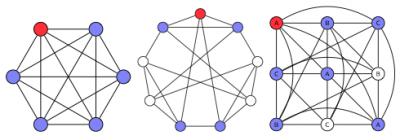

In a complete graph (left) every node is connected to every other. For other well studied graphs, the Paley graph in the center and the Latin square graph on the right, that is not true. A quantum particle could hop directly to the target position, in red, only from connected nodes, marked in blue.
Credit: Tom Wong, UC San Diego
A quantum particle can search for an item in an unsorted “database” by jumping from one item to another in superposition, and it does so faster than a classical computer ever could.
This assertion assumes, however, that the particle can directly hop from any item to any other. Any restriction on which items the particle can directly hop to could slow down the search.
“Intuition says that a symmetric database allows the particle to hop freely enough to retain the quantum speedup, but our research has shown this intuition to be false,” says Tom Wong, a physicist at the University of California, San Diego.
In a paper accepted for publication by Physical Review Letters, the researchers used a technique familiar to physicists called “degenerate perturbation theory” in a novel way to prove that global symmetry is not required for a sped up search.
Information scientists represent the database to be searched as a graph. In globally symmetric graphs, the nodes can be swapped with each other such that the connections between them are preserved. “Strongly regular graphs” don't share this property, but this analysis shows they also support a fast search through local symmetries.
Their finding extends the use of this theory to the field of quantum information science and expands the kinds of data structures on which quantum computing outperforms classical computing.
Jonatan Janmark, KTH Royal Institute of Technology in Stockholm, Sweden and UC San Diego's Department of Mathematics and David Meyer, professor of mathematics at UC San Diego co-authored the work.
The Defense Advanced Research Projects Agency partially supported this work as part of its Quantum Entanglement Science and Technology program. Additional funding came from the Air Force Office of Scientific Research as part of the Transformational Computing in Aerospace Science and Engineering Initiative, and the Achievement Awards for College Scientists Foundation.












